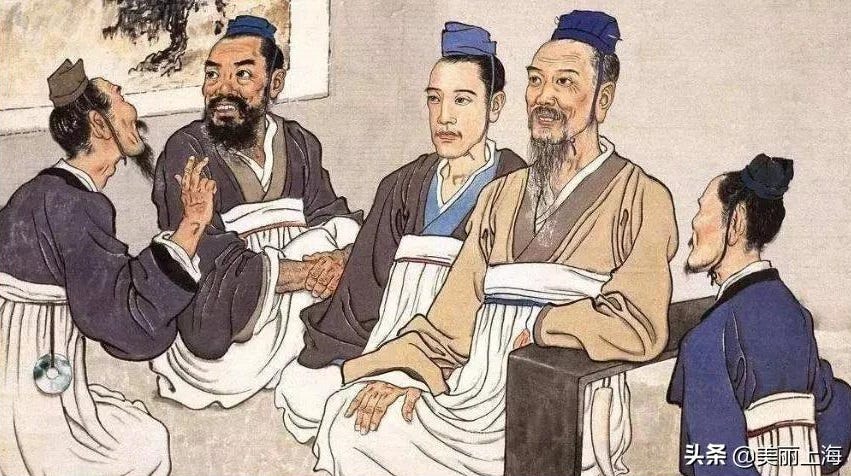Bǝrešiṭ bǝrā ’Elōhîm. בראשית ברא אלהים. ‘In the beginning, God created…’
In modern Chinese, the word xu 序 is used in two ways. First, by itself, it means an ‘introduction’ or a ‘foreword’, a beginning or preface to a text. It is also used in compounds like chengxu 程序 ‘procedure’, cixu 次序 or shunxu 顺序 ‘sequence’, and in dialect constructions like Min (Hokkien) su-si 四序 ‘neat’, ‘cosy’, ‘proper’. The basic glosses denote an order or a rule, or else something set out at the beginning. The modern Chinese Union Bible uses the compound cixu 次序, for example, in reference to the sons of Jacob as they appear before Joseph in Egypt for the second time: in order from oldest to youngest (Genesis 43:33). By contrast, the Hebrew simply says habǝkôr kbǝkôraṭu wǝhaṣā‘îr kṣǝ‘râtu הבכר כבכרתו והצעיר כצערתו ‘the eldest brother by his age, and the youngest brother by his youth’.
This is particularly interesting, because the Biblical Hebrew is closer in certain grammatical respects to Classical Chinese, than modern Chinese is. The ‘order’ doesn’t have to be mentioned. It is implied in the structure of the sentence. Classical Chinese does the same thing: for example, in Confucius’s famous saying ‘fufu, zizi’ 「父父,子子」 ‘[Let the] father [be a] father; [let the] son [be a] son’ (Analects 12.11).
At any rate, the character xu 序 originally figured in Spring and Autumn-era (around 700 BC) bronze inscriptions. In its written structure, it was composed of a measuring-stick (chi 尺) and a pitch-pipe (lü 吕) over a child (zi 子). These three figures together show the realms in which order and sequence are important to the classical Chinese mind: sequence is necessary in physical measurements, in musical scales and notes, and also in determining the duties and privileges (by seniority) of the children in a household. Again, even though the word is not used in the Hebrew, we can see the function at work in the order of the children of Jacob as they arrived in Egypt and presented themselves to Joseph in Genesis.
In later inscriptions, the pitch-pipe and the child were condensed into a single phonetic element, yu 予 (in classical Chinese, this means ‘to accord’, ‘to assign’, ‘to grant’ or simply ‘to give’), while the radical was changed in the Qin-Han transition from chi 尺 to yan 广, which originally signified a lean-to built on the side of a cave, but in classical times came to represent any kind of roof. But the meaning was retained despite the change in structure: ‘order’, ‘series’ or ‘sequence’.
As might be expected, this lexeme was of particular value and importance to the Ritual School (rujia 儒家) of classical studies, of which Confucius was the head and primary figure. Mencius and Xunzi, as well as the Ancient Script scholars Yang Xiong and Wang Chong, favoured this lexeme and accorded ‘order’ a high importance. But it was also important to representatives of the Matrical School (daojia 道家) such as Zhuangzi, who used it to describe the recurring pattern of the four seasons. (Evidently this is the origin of the colloquial Min phrase su-si 四序.) The School of Mo (mojia 墨家) also used this character to refer to the starting-point (duan 端) of a measuring-stick (which is supposedly not in the sequence). But Mo, that conceited little petty engineer who likes to play games with words, introduces a semantic ambiguity. In his writings it is interchangeable with the character hou 厚 ‘thickness’, which has a similar appearance. Thus it is unclear if the starting-point of the measuring-stick in question is a point prior to the sequence, or a point without measurable thickness.
Getting back to the Ritual School. Xunzi is being a bit overblown here, perhaps. But he speaks most eloquently to the importance of order in the Ritual School when he says:
「立大學,設庠序,修六禮,明七教,所以道之也。」
‘To establish the Great Learning, one must lay down a pedagogical order, practice the six rites and understand the seven teachings. This is what the Dao means.’
He then goes on to quote from the Book of Odes: ‘Drink what you drink; eat what you eat; learn what you learn; teach what you teach.’ That is fine: that is his reference. But Xunzi is making a broader point that is applicable to us, who are students of the Hebrew Scriptures—and that is that there is indeed a pedagogical order to those who would study it! The authors of these Scriptures definitely understood the Chinese functionality of xu 序.
The Hebrew Scriptures are ordered according to their generations (tôlǝdot תולדת—note the inter-functionality with the Arabic word tawallud تولد and its connotations of ‘derivation’) and according to their times (dôr דור, from the same Semitic root as the Arabic dawr دور meaning ‘turn’, both in terms of a physical revolution and in terms of a proper sequence or order of events, as in ‘whose turn is it?’). These are the lexemes that correspond to the word xu 序 even in modern Chinese translations of Scripture. Though Xunzi’s reference is of course quite different, he would certainly recognise that there is a prescriptive pedagogical order to the Hebrew Scriptures: this is what we refer to in English (from Latin) as the canon.
The classical Chinese understood implicitly, that the child cannot precede its mother (this is what daode 道德 actually means—and also why it is daode and not dedao!); that the son cannot precede his father (hence, fufu, zizi 父父,子子, in that order); and that the student cannot precede her teacher! This is a lesson that it is nearly impossible to teach the modern, narcissistic Briton or American, who is taught from the beginning to believe practically the reverse. This is the hold that Greek philosophy in general (and Aristotle in particular) still retains on the Western mind: wherein man is given preference over the rest of the created order precisely on account of his novelty.
Yet you are not allowed to start from Lesson 25 and pretend that you understand everything that came before. You must start from Lesson 1. Hebrew Scripture begins—not with the tôlǝdot of man, but with the tôlǝdot of the heavens and the earth. Just as the Daodejing 《道德经》 begins not with man, but with 无名天地之始: the Nameless Origin of Heaven and Earth. And just as the Shijing 《诗经》, the Book of Odes which Xunzi takes as his reference, his canonical origin and the foundation of his pedagogical order—begins not with man… but with doves calling to each other on an island in the midst of a river:
關關雎鳩、在河之洲。
窈窕淑女、君子好逑。‘Guan, guan!’ cry the doves from their isle in the stream.
Slim and elegant is the lady; to the gentleman, a fine match.
Man cannot precede the doves. Not in the Chinese Odes… and not in the Hebrew Scriptures, wherein the birds of the air are children of the Fifth Day, and humans, children of the latter half of the Sixth. It is simply, to quote the Jem’Hadar Third Remata’Klan from Star Trek: Deep Space Nine, ‘the order of things’. Bǝrešit bǝrā ’Elōhîm… ’oṭ ha-šāmayim w’oṭ hā’āreṣ.
The canon is not merely the contents of a corpus. The Western (post-classical Greek, Latin and German) understanding of ‘canon’ as merely the contents—which books are in and which books are out—is largely the result of theological nattering which centres man and gives man precedence over God. This of course gets the question precisely backwards. The canon is also the sequence: the pedagogical order in which Scripture is found. Genesis comes before Exodus. Deuteronomy comes before Joshua. Ezekiel precedes the Scroll of the Twelve. Daniel takes precedence before Ezra. Practising Jews and Muslims understand, as too many Christians (of whatever denominational stripe!) do not, that proper study requires a certain kind of ordering. That ordering is implicit in the acronymic construction Ta-na-ḵ: Tōrah, then Nǝbī‘īm, then Kǝtūbīm. If you read Psalms before Job, you logically approach the latter book in a much different mindset than if you read Job on its own, without having previously been tutored by the Psalmist!
(Many of us Orthodox—and I speak of myself here as well—pretend we understand this. After all, we love to cite the authoritative Pauline teaching from 1 Corinthians that a child must be given milk before he is ready to eat solid food. But then, for whatever reason, we turn around and do not take the pedagogical ordering of the Hebrew scrolls at all seriously from a Liturgical perspective!)
Scripture is, by the way, entitled to break its own rules. Scripture establishes this order, these ṭôlǝdoṭ in Genesis, and right away sets about screwing with our rationalistic human conceptions of how they are supposed to work. Ishmael is the older brother, and Isaac is the younger brother—yet it is through Isaac that the story proceeds. Esau is the older brother, and Jacob is the younger brother—and the story follows Jacob. The story does not follow Jacob’s children in the order it sets out. It is not Reuben, Simeon, Levi or Judah who is the means of saving the Hebrew people, but instead the second-youngest brother, Joseph!
And then, of course, the Hebrew Scriptures proceed to subvert all of their own ‘protagonists’ and turn them inside out. Isaac is literally blind. Jacob is a cheat and a thief. Joseph may save his people, but he also enables their enslavement in Egypt. This is because the true Protagonist is not actually seen in the story, at any time.
But we who are hearing Scripture do not get to break the pedagogical order of the canon: because once we do that, we are no longer submitting to the text. We are instead placing ourselves as the protagonist, and in so doing placing ourselves under Scripture’s condemnation, whether we know it or not. This is what distinguishes a Classics scholar like Xunzi, who respected the order of his canon, from a ‘Confucian’ philosopher like Zhu Xi, who literally made up his own canon and turned Confucianism into a moribund, corrupt, hidebound, rationalist system, as opposed to a living school of textual analysis and commentary!
The Chinese, very much like the Semites, understand pedagogy—and the need to progress from A to B to C, rather than starting at N and skipping around to J, G and Q. They also understand that the Father has His place, and that the Son has His.










